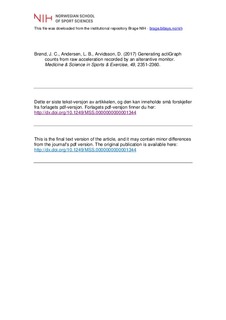| dc.contributor.author | Brønd, Jan Christian | |
| dc.contributor.author | Andersen, Lars Bo | |
| dc.contributor.author | Arvidsson, Daniel | |
| dc.date.accessioned | 2018-11-06T12:41:49Z | |
| dc.date.available | 2018-11-06T12:41:49Z | |
| dc.date.created | 2017-11-24T13:02:18Z | |
| dc.date.issued | 2017 | |
| dc.identifier.citation | Medicine & Science in Sports & Exercise. 2017, 49, 2351-2360. | nb_NO |
| dc.identifier.issn | 0195-9131 | |
| dc.identifier.uri | http://hdl.handle.net/11250/2571251 | |
| dc.description | I Brage finner du siste tekst-versjon av artikkelen, og den kan inneholde ubetydelige forskjeller fra forlagets pdf-versjon. Forlagets pdf-versjon finner du på insights.ovid.com / In Brage you'll find the final text version of the article, and it may contain insignificant differences from the journal's pdf version. The definitive version is available at insights.ovid.com | nb_NO |
| dc.description.abstract | Purpose: This study aimed to implement an aggregation method in Matlab for generating ActiGraph counts from raw acceleration recorded with an alternative accelerometer device and to investigate the validity of the method. Methods: The aggregation method, including the frequency band-pass filter, was implemented and optimized based on standardized sinusoidal acceleration signals generated in Matlab and processed in the ActiLife software. Evaluating the validity of the aggregation method was approached using a mechanical setup and with a 24-h free-living recording using a convenient sample of nine subjects. Counts generated with the aggregation method applied to Axivity AX3 raw acceleration data were compared with counts generated with ActiLife from ActiGraph GT3X+ data. Results: An optimal band-pass filter was fitted resulting in a root-mean-square error of 25.7 counts per 10 s and mean absolute error of 15.0 counts per second across the full frequency range. The mechanical evaluation of the proposed aggregation method resulted in an absolute mean T SD difference of j0.11 T 0.97 counts per 10 s across all rotational frequencies compared with the original ActiGraph method. Applying the aggregation method to the 24-h free-living recordings resulted in an epoch level bias ranging from j16.2 to 0.9 counts per 10 s, a relative difference in the averaged physical activity (counts per minute) ranging from j0.5% to 4.7% with a group mean T SD of 2.2% T 1.7%, and a Cohen_s kappa of 0.945, indicating almost a perfect agreement in the intensity classification. Conclusion: The proposed band-pass filter and aggregation method is highly valid for generating ActiGraph counts from raw acceleration data recorded with alternative devices. It would facilitate comparability between studies using different devices collecting raw acceleration data. | nb_NO |
| dc.language.iso | eng | nb_NO |
| dc.title | Generating actiGraph counts from raw acceleration recorded by an alternative monitor | nb_NO |
| dc.title.alternative | Generating actiGraph counts from raw acceleration recorded by an alternative monitor | nb_NO |
| dc.type | Journal article | nb_NO |
| dc.type | Peer reviewed | nb_NO |
| dc.description.version | acceptedVersion | nb_NO |
| dc.source.pagenumber | 2351-2360 | nb_NO |
| dc.source.volume | 49 | nb_NO |
| dc.source.journal | Medicine & Science in Sports & Exercise | nb_NO |
| dc.source.issue | 11 | nb_NO |
| dc.identifier.doi | 10.1249/MSS.0000000000001344 | |
| dc.identifier.cristin | 1518132 | |
| dc.description.localcode | Seksjon for idrettsmedisinske fag / Department of Sports Medicine | nb_NO |
| cristin.unitcode | 150,34,0,0 | |
| cristin.unitname | Seksjon for idrettsmedisinske fag | |
| cristin.ispublished | true | |
| cristin.fulltext | postprint | |
| cristin.qualitycode | 2 | |
